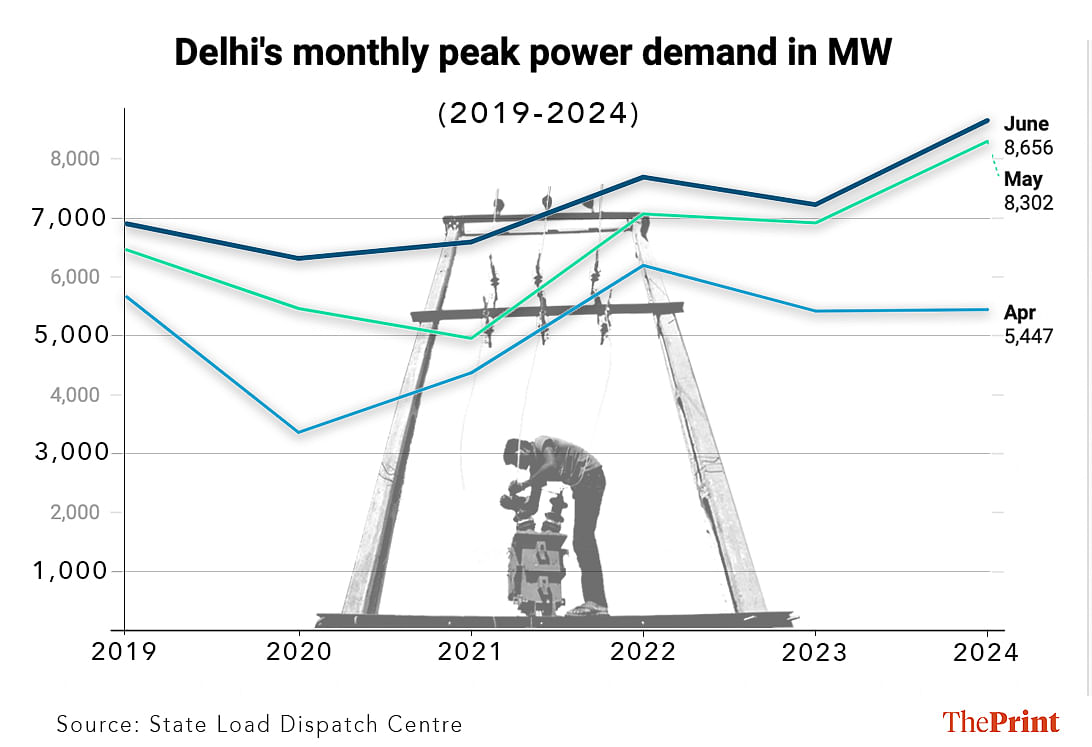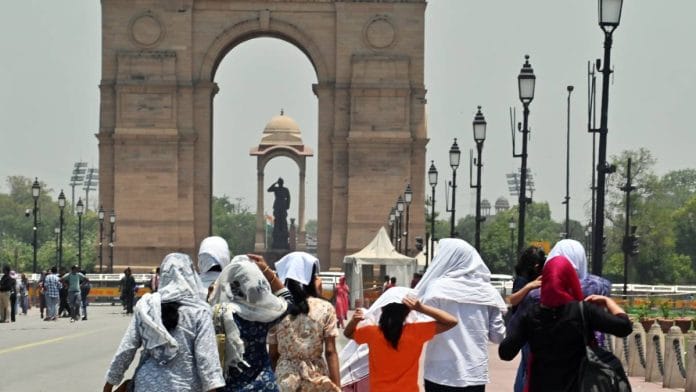New Delhi: Electricity demand in the national capital broke records on 19 June this summer, when 8,656 MW was the highest requirement ever in the region, followed by demand of 8,302 MW on 29 May.
In fact, in the last fortnight of May, Delhi’s power demand crossed 7,000 MW every single day, putting pressure not just on the power generation capacity of the city but also on the grid and transmission lines.
A new report by the Institute for Energy Economics and Financial Analysis (IEEFA) released Friday states that power demand in Delhi grew 3.8 times faster on hot and humid days than on moderate days in the last 12 months, highlighting that cooling needs have driven most of the power demand this summer.
The report draws a comparison between the temperatures in Delhi and the electricity demand in 2022-23 and 2023-24.
The highest electricity demand was seen during the hot and humid days, and is attributed to the use of air-conditioners and fans, and on colder days in the winter season, which is attributed to the use of heaters.
The lowest demand for electricity was recorded when temperatures were moderate – in the range of 17-20 degrees Celsius.
IEEFA’s report used the wet bulb temperature as a measure. Wet bulb temperatures are the measure of heat and humidity, which are considered more dangerous than just dry heat.
Wet bulb temperatures above 35 degrees Celsius can cause extreme health effects, but some studies also suggest that temperatures above 30 degrees Celsius can be harmful too.
In the IEEFA report, wet bulb temperatures above 30 degrees Celsius are taken as “hot and humid” days.
“It is interesting to note that power demand is strongly related to temperature, but even more important is the fact that given such high temperatures, the demand for cooling is a necessity, not a luxury,” Dr Charles Worringham, author of the report, told The Print over phone.
Surging power need
When Delhi first surpassed 7,000 MW power demand in May, Chief Minister Arvind Kejriwal took to X to say that despite the peak demand, the AAP government was providing 24×7 power supply with no blackouts or load-shedding.
However, the IEEFA report does caution against the increasing need for electricity in a growing economy like India, especially given the recurring heat waves during the summer.
ThePrint analysed monthly peak electricity demand in Delhi during the three summer months of April, May, and June between 2019 and 2024. Apart from the decline during the COVID years of 2020 and 2021, the graph shows an upward trend, and especially concerning are the 2024 figures for May and June – they’ve both surpassed 8,000 MW.

In 2023, the June and May numbers saw a slight decline but remained near 7,000 MW, while April peak demand more or less stabilised around 5,500 MW.
IEEFA’s analysis of temperature and power demand for 2022-2023 and 2023-2024 shows a J-shaped graph, indicating high demand during colder and hotter days, and the lowest demand during moderate weather days.
The report also finds that the total number of hot and humid days went from 24 in 2022-2023 to 40 in 2023-2024. While this is concerning, the report says that a deeper analysis is needed to find whether this is part of an increasing trend or a one-off event.
Asked about Delhi’s capacity to meet this growing demand, Worringham pointed to the drawbacks of conventional power sources.
“While most of our energy now is from coal and thermal power plants, there are some limits – many coal-fired plants are already operating at a high capacity of 70 percent, and there are practical limits too like the delivery of coal from far-off fields and transmission over long distances,” he said.
IEEFA’s analysis specifically showed how the increase in power demand from 2022-2023 to 2023-2024 is driven by wet bulb temperatures in Delhi. For example, during moderate temperatures, the year-on-year increase in demand is only 188 MW, but on hot and humid days Delhi’s peak power demand grew by 711 MW, compared to 2023.
The report conducted a larger analysis of the northern region’s power demand too, using Delhi’s temperature data and found similar patterns — demand on hot and humid days was 2.8 times higher than on moderate temperatures days. Further research using local temperature data would yield better results, it said.
Push for solar to meet power demand
Worringham explained that given the constraints of thermal power, Delhi should rapidly increase its renewable energy sources, especially solar, to meet the growing demand.
“We noticed that most of the peak demand is achieved during daytime hours, when solar is available. It is also faster to set up, and closer to the grid to avoid transmission problems,” he said.
According to an IEEFA study of 2023, renewable energy sources contribute around 32 percent of the total energy purchased by Delhi’s discoms. Also, as of March 2023, Delhi had utilised only 13 percent of its total renewable energy potential. But there are plans to expand, especially with the PM Suryoday Yojana for rooftop solar installations announced early this year.
“Increasingly, renewable energy costs are competitive with coal and conventional energy. Unlike thermal power plants though, solar plants are much easier to set up and do not require years of investment and planning,” said Worringham.
“Importantly, with rooftop solar the problem of grid connectivity is also avoided because the installation is local and energy transmission is faster,” he added.
To meet the increasing cooling needs of Delhi’s citizens, Worringham asserted that solar was a potential solution.
(Edited by Nida Fatima Siddiqui)
Also Read: India’s first fully solar village in Gujarat lights up the lives of its poor residents






